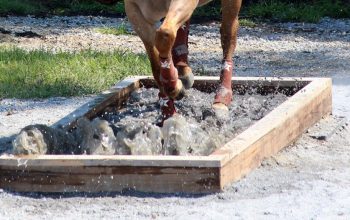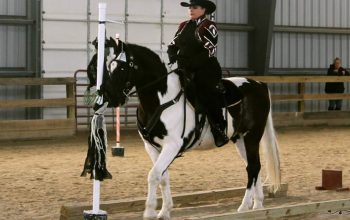By Bev Roberts
North American Trail Ride Conference

Really? You bet! On-the-trail strategy pays off both during the day’s ride and afterwards in camp. Remember, strategy is the art of devising a means to an end with a favorable outcome. Your goal is to complete an enjoyable day’s ride in the allotted time with the least amount of stress on your equine (horse/mule) … and you!
Picture the perfect ride. It is sunny, a light breeze and temperature in the 70’s. Those ahead of and behind you are travelling at your pace but are out of sight. “Old Dobbin” is responding to your most subtle weight shifts. You breeze through obstacles. Pulse and respiration stops (P&Rs) are non-events. You pick up sounds and fragrances of the landscape and wild things. You smile as you complete the ride within your window of time. Your horse has not lost any condition, soundness, trail ability or manners points. Life is good!
KABOOM! You were dreaming … it’s going to take savvy planning to achieve that perfect ride! You must know your horse and yourself.
Does your horse have more go than whoa, buddy easily, remain calm when passed, happily travel at the pace you set, take a while to settle in, jig, jig, jig incessantly? Is your horse impatient, lazy, nervous, grouchy (a kicker), laid back, and so on?

What about you? Do you like being out in front of everyone, being last, or being somewhere in between; like riding with friends or family or riding alone? Do you want to ride your own pace or a group’s pace? Do you get impatient if delayed at an obstacle, fear getting lost? Are you already familiar with the trail?
Knowing yourself and your horse, observing and knowing others, and being aware of ride dynamics, all affect your strategic decisions throughout a ride. You adjust your grand plan as the ride progresses. Let’s start with pacing your ride.
Normally, your strategy will be to walk up and down hills and through rocks and to trot/gait on level ground with good footing. This minimizes physical stress.
Alternating walking and trotting might be in little segments, 50-300 feet at a time, or huge ones, 1-2 miles. The ascents and descents often slow you to ~1.5-2.5 mph, for which you have to trot at ~6-10 mph to average out the pace to a desired say 4-5 mph. Or, your strategy might be to compete on a gaited horse or to teach your horse to walk fast for minimal trotting.
In rides with lots of sand, you should adjust your strategy to trot on the packed sand and walk the deep loose stuff to avoid overworking your horse and risking bowed tendons.
If you or your horse like to be in front, then start first and pace faster than everyone else. However, if you have never ridden a particular ride, you might choose to ride near the front, following the other fast-paced riders. Often the trailmaster repeats or reverses the trail on the second day. Since you have been over the trail on Saturday, you can go out first on Sunday.

By riding up front, you will be riding at your pace, be first at the obstacles (no waiting while one or more riders ahead of you negotiate obstacles), be first in and out of P&Rs, have fewer interactions with others, and be first to return to camp. The last rider usually reaps these same benefits.
If you ride somewhere in between, either by yourself or in a group, look for a “pocket.” This is a gap in the riders where you usually do not see those in front or behind you; but only 1-5 minutes separate you from those other riders. You all travel at the same pace. In that short time cushion, you (or your group) feel like you are riding alone. It also allows those in front of you to clear the next obstacle before you arrive – not to mention clearing the cobwebs, too!
Many rides are in hot or hot and humid conditions. Accordingly, management usually starts riders as soon as it is light enough to see the ribbons marking the trail. You can take advantage of this to move out while the temperature is cool and your horse is fresh. As the day heats up, slow down so your horse is not working as much in the heat. Overall, you achieve the average ride pace.
Another strategic consideration for riding a little faster pace early is, you can see how your pace compares with that set by the trail master. If you arrive at the first identified point before your minimum time, then back off your pace and see how you are doing at the next point; if you arrive after your minimum but before mid-point, you are right on.
By checking your time against the ride map at each point, you can make adjustments for:
- continuing to (hopefully) slow your pace for the rest of the ride,
- saving the cushion you have built so you have extra minutes to
- cool and relax your horse with a long walk into each P&R (especially as the day heats up),
- allow your horse to grab more bites of grass,
- wet your horse down thoroughly at watering spots,
- allow you to take a potty break, or
- allow for the unexpected.

These days, more and more riders are going hi-tech with GPS (Global Positioning System) devices, GPS capable smart phones, and horse heart monitors. The GPS tells you how fast you are going, the distance you have traveled and the average speed for that distance. The heart monitor helps you see if “Old Dobbin” is working too hard. Your strategy might include using these devices. Be forewarned – use your GPS as a guide because each GPS gives different speed and distance readings and will not exactly match the distances given on ride maps.
There are several strategies for keeping track of your ride time. They are a primary timepiece, a secondary timepiece, remembering who started both before and after you, and riding in a group.
Your primary timepiece will be a watch or the clock on your phone or GPS. It gives you the real time, which you note when you leave the timer. You do the math to figure out how long it took to get from one point to the next.
The secondary watch is for ride time. Set it to noon. As you leave the timer, push the button to start the time running. If you are supposed to take 1.5 hours to get to the first point on the map, then, if you are right on time, the watch will read 1:30. So much easier than calculating it in your head using real time.
If you remember who started before and after you and your timing device(s) fails, then you can see where the other riders are. If they left you in the dust, you are probably running late, or vice versa. Or when you see them, you can ask them how they are doing on their time.
You can ride with a group from the start and check with each other to track the time.

This article is part IV of VIII parts. You can view previous parts of this series by following the links below:




